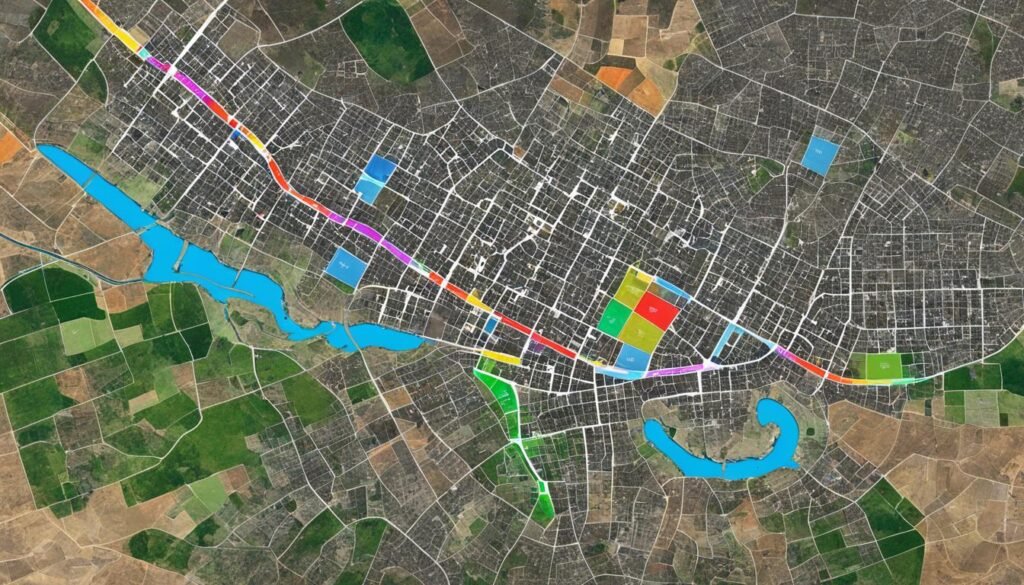California is a state with a multitude of problems and issues that impact the lives of its residents. From environmental challenges to housing crises, it is crucial for us to understand and address these key concerns for the future of our state.
California’s unique geography and diverse population contribute to a range of issues that require urgent attention. In this article, I will explore the major problems we face today and the potential solutions to overcome them.
Key Takeaways:
- California faces various environmental challenges, including wildfires and water scarcity.
- The state is experiencing a severe housing crisis with skyrocketing prices and a shortage of affordable homes.
- Social and political issues, such as income inequality and racial disparities, also pose significant challenges.
- Policy and governance hurdles need to be addressed for effective administration.
- Economic challenges, such as income inequality and job market disparities, must be tackled to ensure prosperity for all.
Environmental Challenges in California
California is currently facing significant environmental challenges that have far-reaching consequences for the state and its residents. These pressing issues include wildfires, droughts, and water scarcity, all of which have had a profound impact on the region’s ecosystem and communities.
One of the most prominent environmental challenges in California is the occurrence of frequent and devastating wildfires. These wildfires have ravaged vast areas of land, destroyed homes and infrastructure, and claimed lives. The state’s unique combination of dry weather conditions, high temperatures, and strong winds create the perfect conditions for wildfires to spread rapidly. As a result, firefighters and first responders work tirelessly to contain and extinguish these fires, putting their lives on the line to protect communities.

In addition to wildfires, California also grapples with recurrent droughts. Prolonged periods of limited rainfall have led to water scarcity throughout the state. Water resources, including rivers, lakes, and reservoirs, have been severely depleted, resulting in water shortages for both residential and agricultural use. This, in turn, has triggered conflicts over water allocation and forced Californians to adopt stricter water usage regulations to conserve this precious resource.
Addressing these environmental challenges requires a multi-faceted approach. The state government has implemented various measures to mitigate the impacts of wildfires, including investing in fire prevention and suppression strategies, as well as improving emergency response capabilities. Similarly, efforts are underway to manage water resources more efficiently, such as implementing water conservation programs and promoting sustainable irrigation practices.
Key Environmental Challenges:
- Wildfires posing a threat to communities and natural habitats
- Droughts leading to water scarcity and conflicts over water allocation
By taking proactive steps to address these environmental challenges, California can work towards creating a more sustainable future and safeguarding its natural resources for generations to come.
Housing Crisis in California
California is grappling with a severe housing crisis that is impacting individuals and communities across the state. The combination of skyrocketing home prices and a shortage of affordable housing options has created a situation where many Californians are facing homelessness and housing insecurity.
The high cost of living in California, coupled with the limited housing supply, has made it increasingly difficult for individuals and families to find stable and affordable housing. As a result, many are forced to live in overcrowded conditions or pay exorbitant amounts of their income towards rent or mortgage payments.
The housing shortage in California has far-reaching consequences. It not only exacerbates income inequality and economic disparities, but it also puts a strain on public resources and services. Homelessness rates continue to rise, and communities are grappling with the social and economic costs associated with this crisis.
To address this pressing issue, innovative solutions are needed. These solutions should focus on increasing affordable housing options, implementing policies that promote sustainable development, and providing support for those experiencing homelessness or housing insecurity.

Key Factors Contributing to the Housing Crisis
- High demand and limited supply of housing
- Rapid population growth
- Inadequate affordable housing options
- Regulatory barriers and complex zoning regulations
- Gentrification and displacement of low-income communities
Addressing the housing crisis in California requires a multi-faceted approach that involves collaboration between government agencies, housing developers, and community organizations. By working together, we can find effective solutions that ensure housing security and affordability for all Californians.
Social and Political Issues in California
California is a state that grapples with a range of social and political issues, which have a profound impact on its residents. These issues encompass a variety of areas including income inequality, racial disparities, educational disparities, and healthcare access. Addressing these challenges is crucial for creating a more equitable and inclusive society.
Income Inequality
One of the major social issues in California is income inequality. The state is known for its stark wealth disparity, with a small percentage of the population owning a significant portion of the wealth. This economic divide creates barriers to upward mobility and contributes to social unrest.
Racial Disparities
California’s diverse population also faces racial disparities across various sectors. The state has a long history of systemic racism, which has resulted in unequal opportunities for people of color in areas such as education, employment, and criminal justice. These disparities undermine social cohesion and hinder the overall progress of the state.
Educational Disparities
The educational system in California grapples with significant disparities. There are disparities in resources, quality of education, and academic achievement among different communities. These inequalities hinder the ability of students to reach their full potential and perpetuate social and economic divides.
Healthcare Access
Healthcare access is another critical social issue in California. While the state has made efforts to increase access to healthcare through programs like Covered California and Medicaid expansion, many individuals still face challenges in accessing affordable and quality healthcare services. These access barriers disproportionately affect low-income individuals and underserved communities.

California’s complex political landscape further compounds these social issues. The state’s diverse population, with varying ideological and cultural backgrounds, often leads to contrasting policy priorities and challenges in reaching consensus. Effective governance and policy-making are essential to address these social and political issues and promote social progress in California.
Public Policy Challenges in California
As a state known for its size and complexity, California faces unique policy challenges in the realm of governance and public administration. Implementing effective policies in such a diverse and populous state can be a daunting task, resulting in bureaucratic hurdles and inefficiencies.
One of the primary challenges is the need to balance the interests and priorities of various stakeholders across the state. With a population of nearly 40 million people and diverse regional needs, crafting policies that are fair and equitable for all Californians is no easy feat.
Furthermore, the interconnected nature of policy areas adds another layer of complexity. Certain policies may have unintended consequences or require coordination across different sectors. For example, addressing environmental challenges often involves collaboration between multiple agencies, industries, and communities.
To improve the state’s overall governance, it is crucial to address these policy challenges head-on. This requires a careful examination of existing policies, identifying areas of improvement, and exploring innovative solutions. Policymakers need to prioritize transparency, accountability, and evidence-based decision-making to ensure policies are effective and meet the diverse needs of Californians.
Collaborative efforts between government agencies, research institutions, and community stakeholders are key to successfully navigating these policy challenges. By fostering partnerships and engaging in open dialogue, policymakers can leverage expertise and insights from various sources to develop well-informed and impactful policies.
Ultimately, addressing the public policy challenges in California is essential for the state’s continued progress and prosperity. By streamlining bureaucracy, fostering collaboration, and staying responsive to the needs of Californians, policymakers can create a more effective and efficient governance framework that serves the best interests of the state and its residents.
Economic Challenges in California
When it comes to the economy, California faces unique challenges that require careful consideration and strategic planning. From income inequality to the high cost of living, the state’s economic issues impact residents from all walks of life.
One of the key economic challenges in California is income inequality. The state has a wide gap between the wealthy and the working class, leading to disparities in opportunities and resources. Addressing this issue is essential for creating a more equitable and inclusive economy.
In addition to income inequality, the high cost of living poses a significant challenge for Californians. Housing prices, transportation expenses, and healthcare costs contribute to the overall burden on residents. Finding ways to make living more affordable is crucial for improving the quality of life in the state.
The job market in California also presents disparities and economic instability. The state heavily relies on certain industries, such as technology and agriculture, which can be vulnerable to shifts in the market. Diversifying industries and creating more economic opportunities across sectors will contribute to a more resilient and stable job market.
Overall, addressing these economic challenges is essential for the long-term economic growth and prosperity of California. By prioritizing income equality, affordability, and job market diversification, the state can create a more robust and inclusive economy that benefits all residents.
Infrastructure Issues in California
California faces significant infrastructure challenges, particularly in the areas of transportation and utilities. The state’s aging roads, bridges, and public transit systems require extensive investment and maintenance to ensure the safety and efficiency of transportation networks.
Moreover, California needs to address critical issues related to water and energy infrastructure to ensure long-term sustainability and resilience. The state must invest in modernizing water and wastewater systems to meet growing demand and mitigate the impact of droughts and water scarcity.
Additionally, there is a pressing need to improve and expand the state’s energy infrastructure to support renewable energy generation and storage. Upgrading and reinforcing the electrical grid will enhance the reliability and stability of the power supply, minimizing the risk of blackouts and supporting a sustainable energy future.
The infrastructure challenges in California require comprehensive planning, funding, and implementation strategies to address the state’s growing needs. By prioritizing investments and adopting innovative solutions, California can ensure a reliable, efficient, and sustainable infrastructure that supports the well-being and development of its residents.
Conclusion
Addressing the problems in California requires a comprehensive approach that involves collaboration between government, policymakers, and community stakeholders. By recognizing and prioritizing key issues such as environmental challenges, housing crises, social and political issues, public policy challenges, economic challenges, and infrastructure issues, the state can work towards finding effective solutions and creating a better future for all Californians.
California’s environmental challenges, including wildfires, droughts, and water scarcity, demand urgent action to protect communities and preserve natural resources. Implementing sustainable practices, investing in wildfire prevention and water management strategies, and promoting renewable energy sources are essential steps towards mitigating these challenges.
Moreover, the housing crisis in California necessitates innovative solutions to address the shortage of affordable housing options and combat homelessness. Increasing housing supply, implementing fair housing policies, and providing support for low-income individuals and families are crucial in ensuring housing security for all Californians.
Furthermore, tackling social and political issues such as income inequality, racial disparities, and healthcare access is vital for building a more equitable and inclusive society. Policymakers must prioritize education reform, healthcare reforms, and social welfare programs to address these concerns and ensure equal opportunities for all residents.
Additionally, addressing public policy challenges and improving governance in California will require streamlining bureaucratic processes, increasing transparency, and promoting public participation in decision-making. By fostering an environment that encourages efficient policy implementation and accountability, the state can overcome hurdles and achieve better outcomes for its citizens.
To bolster the economy, California must focus on diversifying industries, supporting small businesses, and investing in job training and education. Addressing economic challenges such as income disparities and the high cost of living will create greater financial stability and opportunities for residents throughout the state.
Lastly, investing in infrastructure upgrades and maintenance is crucial to ensure safe and efficient transportation systems, reliable utilities, and sustainable water and energy management. By allocating resources for infrastructure improvements, California can enhance its resilience, support economic growth, and provide a better quality of life for its residents.
FAQ
What are the key issues faced by California today?
California faces a range of problems and challenges including environmental issues, housing crises, social and political issues, public policy challenges, economic challenges, and infrastructure issues.
What are the environmental challenges in California?
California is grappling with significant environmental issues such as wildfires, droughts, and water scarcity. Frequent wildfires have caused extensive damage, while prolonged droughts have led to water shortages and conflicts over water allocation.
What is the housing crisis in California?
California is facing a severe housing crisis with high home prices and a shortage of affordable housing options. The rising cost of living and limited housing supply have resulted in homelessness and housing insecurity for many Californians.
What are the social and political issues in California?
California grapples with social and political issues including income inequality, racial disparities, educational disparities, and healthcare access. The state’s diverse population and complex political landscape contribute to the challenges faced in addressing these issues.
What are the public policy challenges in California?
California faces unique policy challenges related to governance and public administration. The state’s size and complexity make it difficult to implement effective policies, resulting in bureaucratic hurdles and inefficiencies.
What are the economic challenges in California?
California’s economy presents challenges such as income inequality, high cost of living, and job market disparities. The state’s reliance on certain industries, such as technology and agriculture, can lead to economic instability during times of crisis.
What are the infrastructure issues in California?
California’s infrastructure faces challenges, particularly in transportation and utilities. Aging roads, bridges, and public transit systems require significant investment and maintenance. The state also needs to address issues related to water and energy infrastructure to ensure sustainability and resilience.
What is the conclusion?
Addressing the problems in California requires a comprehensive approach that involves collaboration between government, policymakers, and community stakeholders. By recognizing and prioritizing key issues, the state can work towards finding effective solutions and creating a better future for all Californians.







